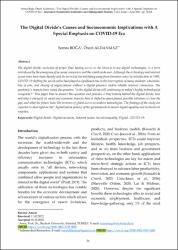The Digital Divide’s Causes and Socioeconomic Implications with A Special Emphasis on COVID-19 Era
Özet
The digital divide, exclusion of people from having access or the literacy to use digital technologies, is a term
introduced by the emergence of personal computers and the world-wide-web. Although the technology and internet
access rates have risen sharply and the term had started fading away from literature since its introduction in 1995,
COVID-19 shifting the world online had played a significant role in the interruption of many students’ education,
loss of jobs, and closing of organizations without a digital presence and/or reliable internet connection. The
pandemic’s impacts have raised the question, “is the digital divide still continuing in today’s highly technological
ecosystem?” This paper tries to answer this question and provides a brief history behind the digital divide, how
and why it emerged, its social and economic impacts, how it shifted as years passed, possible solutions to close the
gap, and what the future looks like in terms of global access to modern technologies. The findings of the study are
expected to shed light on the" digitalization policies of the governments to secure digital equality and inclusion in
societies.
Cilt
2Sayı
1Bağlantı
https://hdl.handle.net/11363/6286Koleksiyonlar
Aşağıdaki lisans dosyası bu öğe ile ilişkilidir:


















